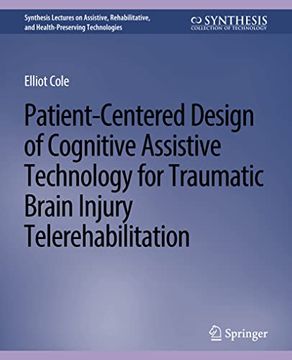Compartir
Patient-Centered Design of Cognitive Assistive Technology for Traumatic Brain Injury Telerehabilitation (en Inglés)
Elliot Cole
(Autor)
·
Springer
· Tapa Blanda
Patient-Centered Design of Cognitive Assistive Technology for Traumatic Brain Injury Telerehabilitation (en Inglés) - Cole, Elliot
$ 836.55
$ 1,673.11
Ahorras: $ 836.55
Elige la lista en la que quieres agregar tu producto o crea una nueva lista
✓ Producto agregado correctamente a la lista de deseos.
Ir a Mis Listas
Origen: Reino Unido
(Costos de importación incluídos en el precio)
Se enviará desde nuestra bodega entre el
Lunes 24 de Junio y el
Martes 02 de Julio.
Lo recibirás en cualquier lugar de México entre 1 y 3 días hábiles luego del envío.
Reseña del libro "Patient-Centered Design of Cognitive Assistive Technology for Traumatic Brain Injury Telerehabilitation (en Inglés)"
Computer software has been productive in helping individuals with cognitive disabilities. Personalizing the user interface is an important strategy in designing software for these users, because of the barriers created by conventional user interfaces for the cognitively disabled. Cognitive assistive technology (CAT) has typically been used to provide help with everyday activities, outside of cognitive rehabilitation therapy. This book describes a quarter century of computing R&D at the Institute for Cognitive Prosthetics, focusing on the needs of individuals with cognitive disabilities from brain injury. Models and methods from Human Computer Interaction (HCI) have been particularly valuable, initially in illuminating those needs. Subsequently HCI methods have expanded CAT to be powerful rehabilitation therapy tools, restoring some damaged cognitive abilities which have resisted conventional therapy. Patient-Centered Design (PCD) emerged as a design methodology which incorporates both clinical and technical factors. PCD also takes advantage of the patient's ability to redesign and refine the user interface, and to achieve a very good fit between user and system. Cognitive Prosthetics Telerehabilitation is a powerful therapy modality. Essential characteristics are delivering service to patients in their own home, having the patient's priority activities be the focus of therapy, using cognitive prosthetic software which applies Patient Centered Design, and videoconferencing with a workspace shared between therapist and patient. Cognitive Prosthetics Telerehabilitation has a rich set of advantages for the many stakeholders involved with brain injury rehabilitation.
- 0% (0)
- 0% (0)
- 0% (0)
- 0% (0)
- 0% (0)
Todos los libros de nuestro catálogo son Originales.
El libro está escrito en Inglés.
La encuadernación de esta edición es Tapa Blanda.
✓ Producto agregado correctamente al carro, Ir a Pagar.

